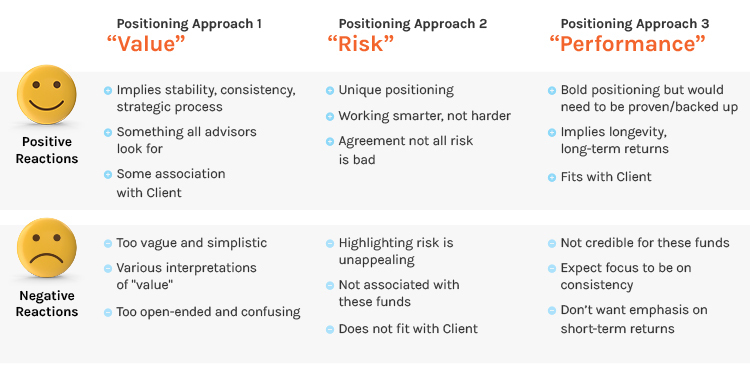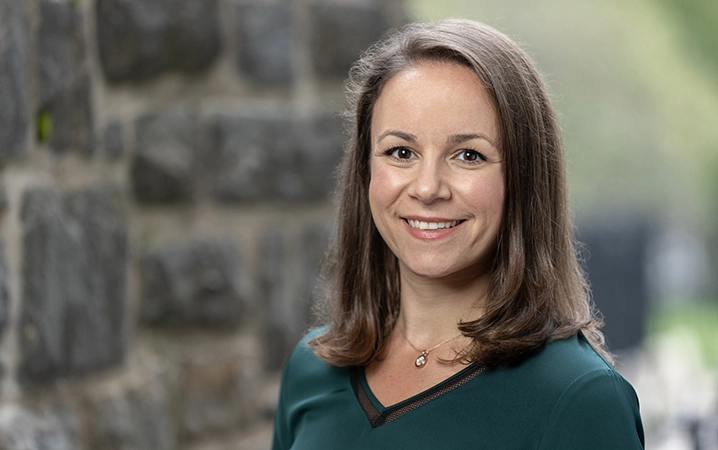Case Study
Business Issue
A major financial services company wanted to expand market recognition among financial advisors as an authority on a specific type of fund. They sought to identify the key insights that could help them develop and refine a communication strategy to build awareness and capture market share in the fund category.
Custom Approach
Radius designed a Mixed Methodology approach that combined qualitative and quantitative research with professionals who had with deep knowledge of the funds.
Methodology
Step 1: Understand how advisors think about specific funds and the select provider.
During the exploratory phase, we discussed the types of funds that are critical components of a diversified portfolio. We discovered:
- The fund in the study is essential to a well-designed, diversified portfolio to stabilize/offset volatility.
- Advisors seek top providers in the market who demonstrate a deep level of knowledge and have access to critical information.
- Funds are evaluated based on long-term performance, safety, upside capture, and investment process.
- A lack of transparency and volatility connected with the fund was expressed as a concern.
- Advisors are currently using a variety of different firms, but the company in our study was not top of mind for this type of fund.
Step 2: Capture reactions to potential broad positioning approaches.
The initial research revealed good market observations, but no clear winning statements. This created an opportunity for our team to strengthen the initial approach to positioning and drive more distinction.
We identified three approaches to test – value, risk, and performance – and asked for positive and negative reactions for each approach. Our results helped to clarify positioning.

Based on the revised feedback, we were able to expand the three approaches into five fleshed-out positioning statements as we moved into the RTCO phase.
Step 3: Real-Time Concept Optimization to enhance positioning.
This step is where advisors were asked to provide continual, real-time feedback to improve and evolve the statements. Each round of feedback brought greater focus and consistency to the messaging that would resonate most effectively.
At the end of the real-time concept optimization, participants then ranked the positioning statements in order from strongest to weakest.
Across all six focus groups, advisors provided valuable insights as to how they want fund providers to communicate with them. Their insights:
- Use a personal approach by speaking in the first-person, and create advertising that speaks directly to advisors.
- Use down-to-earth, layman’s terms in a professional but unpretentious voice.
- Back up claims with hard evidents that supports bold statements about the fund.
- Help fund managers talk with their clients by including descriptions advisors could use in marketing materials, and make those messages easy to understand.
Step 4: Validate performance of the top three positioning statements via flash poll.
Based on real-time feedback, the top five positioning statements were pared down to the following three concepts for validation via an online, 24-hour flash poll:
- Consistent performance
- Reliable process
- Expertise
The concepts “consistent performance” and “reliable process” tested similarly, but when pressed to select one, advisors preferred “performance”.
The flash poll also provided guidance on potential barriers the company could address given their lack of association with these funds.
Growth outcome
The Mixed Methodology approach that invites advisors to provide real-time feedback combined with online concept testing was able to deliver clear and instructive insights. This allowed the fund provider to structure compelling and effective messaging and a go-to-market strategy. Real-Time Concept Optimization improved go-to-market messaging by inviting customers to provide and refine input.
- Insight 1: The fund communication should focus on messages about consistent performance, the team’s experience with fund management, and the fund’s low volatility.
- Insight 2: Proof points are critical. Advisors want to be assured that the company can back up its claims with evidence using simple language that advisors’ clients could understand.
- Insight 3: As a provider not known for managing this type of fund, the company could take steps to address advisors’ lack of familiarity with key messaging.
Expert interviews are an ideal way for financial services firms to get reliable market insights. Read more.
Ready to learn more about using Real-Time Concept Optimization for go-to-market messaging?



